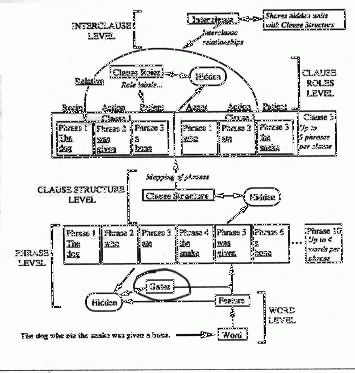|
Jain (1991)experimented with a network that received
the words of a sentence one at a time, and would
produce a representation of the sentence that included
phrase structure, clause structure, semantic role
assignment, and inter-clause relationship. Words were
presented by activating each word's associated word
unit. This produced an activation pattern in the group
of nodes assigned the task of representing word
meaning. These word meanings were then grouped into
contiguous phrase blocks by the Phrase Level (so, for
example, if the dog who ate the snake was given a
bone was entered, the phrase level would divide it into
[The dog][who][ate][the snake][was given][a bone] ).
The Clause Structure Level assembled phrase blocks into
clauses ("For example, ‘[The dog][who][ate][the
snake][was given][a bone]' is mapped into ‘[The dog]
[was given][a bone]' and ‘[who][ate][the snake]'.").
The Clause Role level labeled words according to roles
and relationships in each clause, such as (Agent,
Action, Patient). The Inter-clause Level represented
the relationships between clauses, such as "clause 2 is
relative to the first phrase block of clause 1."
Phrase Level, Clause Role Level and Clause Structure
and Inter-clause Level were trained independent of one
another. The phrase and Clause Roles modules were
constructed by training a group of nodes to process
any phrase block in the training set and then
replicating them 10 times. This allowed the final
network to process a phrase regardless of where in the
sentence it appeared.
|

 Back to the Table of Content
Back to the Table of Content